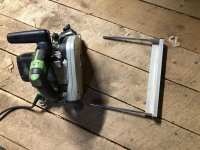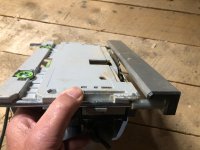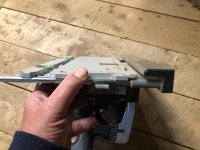I scarfed short, rough sawn boards together to make long boards for full length strips. Then used a chalk line, skil-saw and block plane to establish a straight, smooth edge. Then the skil-saw method to rip strips. I did not plane the rough sawn boards to thickness before ripping strips. I sized them on the second pass of the bead and cove operation by running them between the fence and bit on the router table, as Jim has posted in the past. It saved a step, worked well, and eliminated needing to buy a planer!
-
Happy Sacagawea Day! 🧭🧑🏽🍼🪶🏞
You are using an out of date browser. It may not display this or other websites correctly.
You should upgrade or use an alternative browser.
You should upgrade or use an alternative browser.
SkilSaw Method for Strip Cutting ... a primer
- Thread starter Cruiser
- Start date
Personally, I usually use rough lumber (at least 16') and plane to the thickness I want my strips, saves sizing the strips later. Then I go straight to the circular saw, the first strip from the rough edge is usually not viable, after the first cut they are all fine. The guide is pretty short so any curve in the rough lumber just gets followed and the strip thickness stays constant.
There is likely no question that a band saw blade will give you more strips per board, but it will be a lot more work to setup ... as outlined in the original post.
"Talk about a thin kerf! Your wood will go a lot further with a band saw than the thinnest thin-kerf table saw blade"
To try and quantity this statement, I did a few rough calculations, assuming the bandsaw blade at 1/32" and circular blade at 1/16" using a 6" wide board, in theory you can expect a band saw to produce 21 strips and the thin kerf circular blade to produce 19 strips ... while that is more strips from the band saw, on a boat level of total strips required, it amounts to 6-7 strips difference ... most of us will cut a few extra, so it really gets to be a wash IMO.
Brian
Even if it's only a savings of two strips per 6 inch wide board, how do you figure only a 6-7 strip savings per boat? Are you telling me you use a total of only a little over three 6 inch wide boards to build an entire canoe?? How long are your strips?
Even if it's only a savings of two strips per 6 inch wide board, how do you figure only a 6-7 strip savings per boat? Are you telling me you use a total of only a little over three 6 inch wide boards to build an entire canoe?? How long are your strips?
I only use full length strips, whether they are purchased or skarfed together before cutting strips. A canoe takes ~72 full length strips to complete, plus or minus a few assuming the standard 3/4" strips, so my last build was 4 1" x 4" x 16' and 1 1" x 6" x 16' .... and I have about 24 strips left over. A boat should take about 3+ boards ( at 6"), since most ppl would rip that "+" part ( or 4th board) anyway, there are extra strips for most builds I have done.
At an extra 2 strips per board, that would be a difference in strip production for the entire boat or 8 strips assuming you go ahead and just rip up that entire 4th board.
That is just an estimate with the math ...obviously stuff happens in the real world, but I am trying to put this kerf business into context with what it really means to a build. Once you get that kerf down, as the thin kerf blades do, the impact starts to not be so important anymore.
Anybody with other blade dimensions, please chime in, I measured the blade on my circular saw and looked an average bandsaw blade up ... that doesn't make it gospel, just a start ....
Brian
I only use full length strips, whether they are purchased or skarfed together before cutting strips. A canoe takes ~72 full length strips to complete, plus or minus a few assuming the standard 3/4" strips, so my last build was 4 1" x 4" x 16' and 1 1" x 6" x 16' .... and I have about 24 strips left over. A boat should take about 3+ boards ( at 6"), since most ppl would rip that "+" part ( or 4th board) anyway, there are extra strips for most builds I have done.
At an extra 2 strips per board, that would be a difference in strip production for the entire boat or 8 strips assuming you go ahead and just rip up that entire 4th board.
That is just an estimate with the math ...obviously stuff happens in the real world, but I am trying to put this kerf business into context with what it really means to a build. Once you get that kerf down, as the thin kerf blades do, the impact starts to not be so important anymore.
Anybody with other blade dimensions, please chime in, I measured the blade on my circular saw and looked an average bandsaw blade up ... that doesn't make it gospel, just a start ....
Brian
I suppose how many strips would depend a bit on the canoe's design -- length, width, tumblehome versus straight, etc.
But assuming 72 strips, another way to look at is how many potential strips get "wasted" making sawdust. Using 1/16th kerf, every four strips you cut, you have "lost" a strip to sawdust. So in making 72 strips you lost 18 strips to sawdust. With a 1/32 kerf, every 8 strips you cut you lose a strip's worth of sawdust. So to make 72 you would lose 9.
In my case, I was going from a 3/32nds "thin kerf" table saw (not circular saw) blade to a 1/32nd band saw blade, so the savings were more pronounced.
I have always bought #3 and better 1x planks.
One face and two sides are planed. The other face is rough.
If you plan to hand bevel, or Roto Bevel ( Nick's Cool Tool ) you need to plane both faces.
I solve the issue of uneven plank thickness, by Bead and Coving my strips. Running the strips Between the bit and fence. to uniform the width, of the strips.
I would love to find locally, Rough sawn WRC !
One face and two sides are planed. The other face is rough.
If you plan to hand bevel, or Roto Bevel ( Nick's Cool Tool ) you need to plane both faces.
I solve the issue of uneven plank thickness, by Bead and Coving my strips. Running the strips Between the bit and fence. to uniform the width, of the strips.
I would love to find locally, Rough sawn WRC !
Remember you're ripping along the grain. The strips are as clean as they can be in my experience with the thin kerf, 24 tooth blade. In my experience a fine tooth blade wouldn't work for this. Personally I haven't seen a circular saw with a bag, although one of my circular saws has a port. The port shoots about 40% of the coarser stuff in a slightly different direction, but most of that ends up on you or on the top of the board. Even so, I can't imagine what a pain it would be to try and manage a dust collection hose while cutting strips. All this is just my opinion, I could be wrong about all of it.
Mark
sorry, you are wrong you can get veneer blades with ripping teeth, I have some with as few as 14 teeth with huge gullets. and you're comparing static ejection to vacuum ejection, My hoses are on overhead tracks and far less annoying than a face full of dust, I'd estimate 90- 95% extraction.
here's one with 16 teeth and a .062 kerf https://www.amazon.ca/Milwaukee-48-40-4116-Endurance-Framing-Knockout/dp/B00004WHJH
sorry, you are wrong you can get veneer blades with ripping teeth, I have some with as few as 14 teeth with huge gullets. and you're comparing static ejection to vacuum ejection, My hoses are on overhead tracks and far less annoying than a face full of dust, I'd estimate 90- 95% extraction.
here's one with 16 teeth and a .062 kerf https://www.amazon.ca/Milwaukee-48-40-4116-Endurance-Framing-Knockout/dp/B00004WHJH
I think the confusion here is that you are calling this by a different name, what you posted is a "framing/ripping" blade, not a veneer blade ... which is exactly what the OP suggested. It is also a 1/16" as mentioned a few posts up, where we "did the math".
I personally have never seen a circular saw with any sort of vacuum setup. maybe you could post a pic for us, this thread is for learning purposes, so anything to make the saw part safer and cleaner holds interest for me.
Brian
Festool is one brand with dust extraction and it is awesome. It also has a fence purpose made, no need for the angle iron (aluminum).
Jim
also the blade retracts upward into the housing so no exposed blade when not cutting.
Jim
also the blade retracts upward into the housing so no exposed blade when not cutting.
Festool is one brand with dust extraction and it is awesome. It also has a fence purpose made, no need for the angle iron (aluminum).
Jim
also the blade retracts upward into the housing so no exposed blade when not cutting.
Maybe you could share a link ?
I see a Track saw by Festool, but it won't work for long planks.
Maybe you could share a link ?
I see a Track saw by Festool, but it won't work for long planks.
I own one of the track saws and I agree with the track it wouldn't be suitable for strip cutting. Not because of the length (the track sections can be joined to any length you want although it would cost $$$) but because the track would need to be repositioned after every cut.
However, I see Festool now sells a parallel fence guide accessory that basically would do what the improvised fence on a regular circular saw does:
https://www.festool.com/accessory/491469---pa-ts-55#Overview
I don't own the parallel guide.
Here is what I have I have used multiple track sections to straighten one edge of a mahogany plank, then slid in the parallel guide and ripped off two nice gunnels. I originally bought the saw for the (at the time) superior dust collection as I had developed an allergy to teak and cedar. It still is one of the best investments I’ve made. Yes very expensive, but there are other options in today’s market. The parallel guide came with the saw if I remember correctly.



Jim



Jim
That's what I was referring to! I don't have one but I see it could be very helpful with strip cutting. I have an 8 foot and a 4 foot section of track, so if I bought that fence (don't think it came with mine), I'd be in strip cutting heaven.
I've not seen this setup.
It looks like it will work, and if the blade retracks above the base ? A much safer option !
Yes I know about the expense of Festools, but also know many satisfied users of their tools !
The improvements I would make to the Festool ? Lengthen the fence, and add a handle for your Right hand.
Thanks for the pics Jim !
It looks like it will work, and if the blade retracks above the base ? A much safer option !
Yes I know about the expense of Festools, but also know many satisfied users of their tools !
The improvements I would make to the Festool ? Lengthen the fence, and add a handle for your Right hand.
Thanks for the pics Jim !
I looked up the Festool prices and I have to admit I cringed a little .... I would have to think long and hard before spending that on a circular saw. I think a respirator and wheeling the strongback to the driveway to cut strips will have to do for me at present.
Brian
Brian
If that was my primary need Brian I would have to agree with you. But it excels at breaking down plywood too. When teak plywood is $400 dollars a sheet I don’t want to have to wrestle it through a tablesaw. Oh yea and splinter free. Enough, I’m not try to sell anyone, I was also in business so could right off the expense on my taxes.
Jim
Jim
If that was my primary need Brian I would have to agree with you. But it excels at breaking down plywood too. When teak plywood is $400 dollars a sheet I don’t want to have to wrestle it through a tablesaw. Oh yea and splinter free. Enough, I’m not try to sell anyone, I was also in business so could right off the expense on my taxes.
Jim
Yes, it absolutely excels at breaking down sheet goods; and it's no exaggeration that the cuts are splinter free (and straight as an arrow). And the dust collection is better than most table saws to boot.
Have you managed to find any good thin kerf blade to fit the Festool saw for ripping strips?Here is what I have I have used multiple track sections to straighten one edge of a mahogany plank, then slid in the parallel guide and ripped off two nice gunnels. I originally bought the saw for the (at the time) superior dust collection as I had developed an allergy to teak and cedar. It still is one of the best investments I’ve made. Yes very expensive, but there are other options in today’s market. The parallel guide came with the saw if I remember correctly.
View attachment 124120 View attachment 124119 View attachment 124118
Jim
I used mine with a long vacuum hose that I rigged so it did slide along the strongback as I was cutting. The festool dust collection is indeed stellar. With the thick blade it was slow cutting though. The machine even stopped a few times from overheating.
No I haven’t, but honestly haven't had a need in quite a few years. There is a big Festool dealer a bit south of me so I might check next time I drive that way. I haven’t been on the FOG forum in over a year but might be worth a look and see what others has found.
Jim
FOG= Festool Owners Group
Jim
FOG= Festool Owners Group
I just spoke to Festool customer service and It seems that there are no thin-kerf blades that will fit the Festool TS55. That's a shame because the machine is very good, especially with the aluminium guide and dust extraction is excellent. Because the riving knife is quite thick it would stick in the track from a thin kerf blade. There's probably some modifications that could be done to it. Might just be more feasible to get a dedicated thin kerf machine and use the Diablo blade on it.No I haven’t, but honestly haven't had a need in quite a few years. There is a big Festool dealer a bit south of me so I might check next time I drive that way. I haven’t been on the FOG forum in over a year but might be worth a look and see what others has found.
Jim
FOG= Festool Owners Group
Right, I forgot that it has a riving knife. That would bind up for sure.
Jim
Jim
Similar threads
- Replies
- 78
- Views
- 10K
- Replies
- 7
- Views
- 1K
- Replies
- 28
- Views
- 5K
